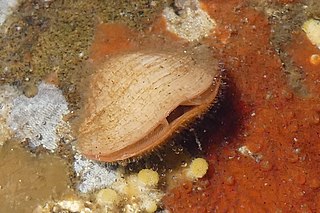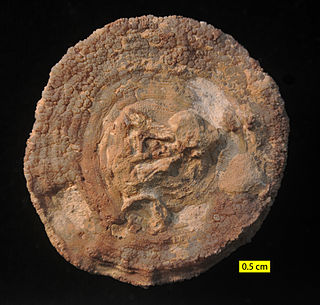
Tentaculites is an extinct genus of conical fossils of uncertain affinity, class Tentaculita, although it is not the only member of the class. It is known from Lower Ordovician to Upper Devonian deposits both as calcitic shells with a brachiopod-like microstructure and carbonaceous 'linings'. The "tentaculites" are also referred to as the styliolinids.

Craniata is a class of brachiopods originating in the Cambrian period and still extant today. It is the only class within the subphylum Craniiformea, one of three major subphyla of brachiopods alongside linguliforms and rhynchonelliforms. Craniata is divided into three orders: the extinct Craniopsida and Trimerellida, and the living Craniida, which provides most information on their biology. Living members of the class have shells which are composed of calcite, though some extinct forms my have aragonite shells. The shells are inarticulate and are usually rounded in outline. There is no pedicle; the rear edge of the body cavity is a smooth and flat wall perforated by the anus. This class of brachiopods has an unsupported lophophore with only a single row of tentacles. In the absence of a pedicle, the shell is usually attached directly to a hard substrate. Many craniiforms are encrusting animals which attach directly to the shell of another animal, usually another brachiopod. The plicae from the host brachiopod will then appear within the shell of the craniiform.

Pelagic sediment or pelagite is a fine-grained sediment that accumulates as the result of the settling of particles to the floor of the open ocean, far from land. These particles consist primarily of either the microscopic, calcareous or siliceous shells of phytoplankton or zooplankton; clay-size siliciclastic sediment; or some mixture of these. Trace amounts of meteoric dust and variable amounts of volcanic ash also occur within pelagic sediments. Based upon the composition of the ooze, there are three main types of pelagic sediments: siliceous oozes, calcareous oozes, and red clays.
The Obolellata are a class of Rhynchonelliform brachiopods with two orders, Obolellida and Naukatida. They are essentially restricted to the lower-middle Cambrian.

Taxonomy of commonly fossilised invertebrates is a complex and evolving field that combines both traditional and modern paleozoological terminology. This article aims to provide a comprehensive overview of the various invertebrate taxa that are commonly found in the fossil record, from protists to arthropods. The taxonomy presented here is not intended to be exhaustive but focuses on invertebrates that are either popularly collected as fossils or are extinct. Special notations are used to highlight invertebrate groups that are important as fossils, very abundant in the fossil record, or have a large proportion of extinct species. These notations are explained below for clarity:
A valve is each articulating part of the shell of a mollusc or another multi-shelled animal such as brachiopods and some crustaceans. Each part is known as a valve or in the case of chitons, a "plate". Members of two classes of molluscs, the Bivalvia (clams) and the Polyplacophora (chitons), have valves.

Siliceous ooze is a type of biogenic pelagic sediment located on the deep ocean floor. Siliceous oozes are the least common of the deep sea sediments, and make up approximately 15% of the ocean floor. Oozes are defined as sediments which contain at least 30% skeletal remains of pelagic microorganisms. Siliceous oozes are largely composed of the silica based skeletons of microscopic marine organisms such as diatoms and radiolarians. Other components of siliceous oozes near continental margins may include terrestrially derived silica particles and sponge spicules. Siliceous oozes are composed of skeletons made from opal silica SiO2·nH2O, as opposed to calcareous oozes, which are made from skeletons of calcium carbonate (CaCO3·nH2O) organisms (i.e. coccolithophores). Silica (Si) is a bioessential element and is efficiently recycled in the marine environment through the silica cycle. Distance from land masses, water depth and ocean fertility are all factors that affect the opal silica content in seawater and the presence of siliceous oozes.

Discinisca is a genus of brachiopods with fossils dating back from the Early Devonian to the Pliocene of Africa, Europe, North America, and New Zealand.

Strophomenida is an extinct order of articulate brachiopods which lived from the lower Ordovician period to the mid Carboniferous period. Strophomenida is part of the extinct class Strophomenata, and was the largest known order of brachiopods, encompassing over 400 genera. Some of the largest and heaviest known brachiopod species belong to this class. Strophomenids were among the most diverse and abundant brachiopods during the Ordovician, but their diversity was strongly impacted at the Late Ordovician mass extinction. Survivors rediversified into new morphologies in the Silurian, only to be impacted once again at the Late Devonian mass extinction. However, they still survived till the mid Carboniferous.

Brachiopods, phylum Brachiopoda, are a phylum of trochozoan animals that have hard "valves" (shells) on the upper and lower surfaces, unlike the left and right arrangement in bivalve molluscs. Brachiopod valves are hinged at the rear end, while the front can be opened for feeding or closed for protection. Two major categories are traditionally recognized, articulate and inarticulate brachiopods. The word "articulate" is used to describe the tooth-and-groove structures of the valve-hinge which is present in the articulate group, and absent from the inarticulate group. This is the leading diagnostic skeletal feature, by which the two main groups can be readily distinguished as fossils. Articulate brachiopods have toothed hinges and simple, vertically oriented opening and closing muscles. Conversely, inarticulate brachiopods have weak, untoothed hinges and a more complex system of vertical and oblique (diagonal) muscles used to keep the two valves aligned. In many brachiopods, a stalk-like pedicle projects from an opening near the hinge of one of the valves, known as the pedicle or ventral valve. The pedicle, when present, keeps the animal anchored to the seabed but clear of sediment which would obstruct the opening.

The origin of the brachiopods is uncertain; they either arose from reduction of a multi-plated tubular organism, or from the folding of a slug-like organism with a protective shell on either end. Since their Cambrian origin, the phylum rose to a Palaeozoic dominance, but dwindled during the Mesozoic.

Testate amoebae are a polyphyletic group of unicellular amoeboid protists, which differ from naked amoebae in the presence of a test that partially encloses the cell, with an aperture from which the pseudopodia emerge, that provides the amoeba with shelter from predators and environmental conditions.

Rhynchonelliformea is a major subphylum and clade of brachiopods. It is roughly equivalent to the former class Articulata, which was used previously in brachiopod taxonomy up until the 1990s. These so-called articulated brachiopods have many anatomical differences relative to "inarticulate" brachiopods of the subphyla Linguliformea and Craniformea. Articulates have hard calcium carbonate shells with tongue-and-groove hinge articulations and separate sets of simple opening and closing muscles.
Discradisca is a genus of brachiopods.
Pelagodiscus is a monospecific genus of discinid brachiopods. Silica tablets leave a distinctive tesselating imprint on the inner surface of its shell.
Mickwitziids are a Cambrian group of shelly fossils with originally phosphatic valves, belonging to the Brachiopod stem group, and exemplified by the genus Mickwitzia – the other genera are Heliomedusa and Setatella. The family Mickwitziidae is conceivably paraphyletic with respect to certain crown-group brachiopods.

Argyrotheca is a genus of very small to minute lampshells. All species share a large pedicel opening, one ridge on the inside of the pedunculate valve, pits in a diamond pattern on the inside of both valves, and without radial ridges that end in tubercles. It occurs in depths between 6 and 1300 m. It is known since the latest Cretaceous.

Beekite is a distinctive form of chalcedony usually associated with silica replacing carbonate minerals in fossils.
Acrotheloidea is a superfamily of Discinid brachiopods, alternatively ascribed to the lingulids—for a discussion of discinid taxonomy, see Discinida.

Kutorginates (Kutorginata) are an extinct class of early rhynchonelliform ("articulate") brachiopods. The class contains only a single order, Kutorginida (kutorginides). Kutorginides were among the earliest rhynchonelliforms, restricted to the lower-middle part of the Cambrian Period.













